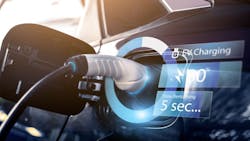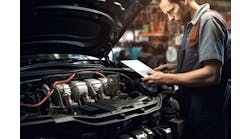It’s officially 2023. While the modern world may not look quite like the one predicted by “The Jetsons” television show, technology has still crafted much of today’s society and that certainly includes the automotive aftermarket. Just because flying cars aren’t the norm, that doesn’t mean vehicle technology isn’t vastly different than it was even just a few years ago, and shops are paying attention.
All it takes is one look at the 2022 Ratchet+Wrench Industry Survey to understand how shops are engaging with vehicle technology. For example, 32% of respondents noted a shop specialization of hybrid repair and 13% said that they specialized in electric vehicle repair.
Additionally, 61% of survey respondents cited ADAS as their intention for investment in the next five years, and 41% said it would be EVs.
As the industry settles into a new year, these responses have the potential to become an especially vital component of the approach to automotive repair. That’s because innovative technologies are not going to stop emerging. The way vehicles are repaired will continue to shift, and it is important to stay informed.
So, what exactly is the forecast for vehicle trends and technology for 2023? Ratchet+Wrench reached out to a few industry experts to hear their thoughts.
Ben Johnson, director of product management at Mitchell 1
“In my opinion, the same two trends we started 2022 with will be the same two trends that will be prominent in 2023: The continued growth of electric vehicles (BEV, HEV, PHEV) and vehicles equipped with ADAS coming into the shop.
For ADAS, the realization has to come that whether a shop knows it or not, they are working on ADAS just by doing routine thrust angle alignments and many other ‘non-ADAS-specific' types of repairs. In addition to those, vehicles equipped with ADAS features are now aging to the point we should begin to see some sensor failures, etc. Shops are going to have to ask themselves how they are going to ensure these vehicles are returned to their owners in proper operating condition.
Regarding electric vehicles, again, while the popularity of these vehicles varies regionally, shops need to understand it’s not a question of ‘if;’ it’s a question of ‘when’ these vehicles start showing up in your service bays. Turning them away is not a solution for growth. Addressing them, like many other emerging technologies we’ve dealt with over the years, will require some training and some gear, but most of the repairs are going to be repairs we’re used to (brakes, suspension, steering, CV joints etc.)
To summarize, I would say the challenges are really, as they’ve always been, for the shop owner to accept and embrace that new technologies mean new opportunities. Ignoring them has never been a good business decision. Embrace them and reap the long-term rewards!”
Allison A. Whitney, content manager at AUTEL
“I think the challenges facing shops in the next year will include how to service new energy vehicles such as electric and hybrids and enabling technicians to access the education, training, and tools needed. Another challenge will be servicing the increasing number of vehicles with advanced driver-assistance systems such as automatic emergency braking, lane keep assist, and blind spot monitoring.
Calibrating the input devices (camera, LiDar, Radar) inherent in these systems requires a shop to have significant space and a comprehensive calibration frame system, and skilled technicians.”
Duane ‘Doc’ Watson, technical trainer at Bosch Automotive Aftermarket
“With this surge in electric vehicles, automotive repair shop owners and technicians will need to make decisions on electric vehicle-related training and tools/equipment. Of course, these decisions are not easy and whatever a shop owner decides will be based on many factors including the following:
Does investing in EV tools and equipment make sense for my market/customer base?
An automotive repair shop in California, the state with the largest density of EV drivers, will most likely consider investing in tools and equipment given electric vehicles are likely to come through the shop. On the flip side, a shop in a rural region/state, where there are far fewer electric vehicles on the road, may not have to invest in certain resources until EVs become more prominent in that area.
Should I be an early adopter–regardless of market?
When we view automotive technology historically, there is no shortage of shifts that challenged shop owners to adapt to new norms. For instance, when ADAS was first introduced, many shop owners across the country viewed it as a niche. Today, pretty much every new vehicle sold has some level of ADAS and it has become vital technicians are trained and up to date with tools and techniques.
Electric vehicles will be the norm one day and for many automotive repair shops, especially in rural areas, it may be smart to invest resources into technician training and equipment that’s applicable to EVs and gas-powered vehicles–high-capacity lifting tables for instance are a perfect example of equipment that is essential for EV repairs yet can be used in gas-powered vehicle repairs.
How can EV equipment be a marketing option to draw new customers?
Being capable of servicing electric vehicles is very niche, however, the market for it is there. Servicing and providing amenities to EV owners–including offering charging stations–could be used as a way to attract and retain new customers.
Cars are becoming more like computers every year, which means shop owners will have to pay attention to tool and equipment updates, as well as make sure their technicians are properly trained and up to date with new technology.
If shop owners aren’t up to date on industry news, tool updates, and new requirements from OEMs then they run the risk of missing out on vital information which could directly correlate to how they service their customers. For instance, ADAS recalibration is becoming ever more important, but the processes can change with new vehicle models and are not the same across manufacturers. That’s why it’s important to have technicians of all skill levels to be enrolled in multiple training sessions a year.”



